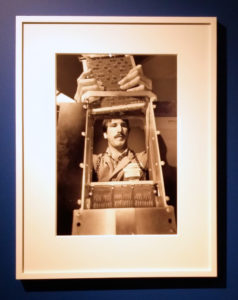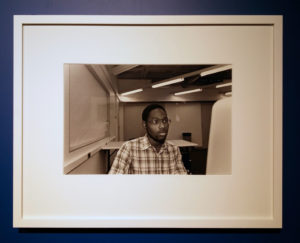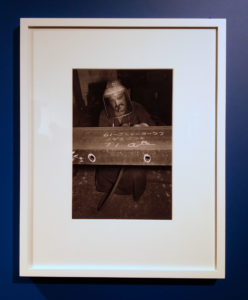 After his studies of photography, Lee Friedlander took black and white photos from street scenes, Jazz musicians, landscapes and much more. So he became known as a chronicler of the American everyday life. His style is recognised as “social landscapes”. From 1979 to 1995, he shot various series of industrial work. Within 16 years, he visited factories and other production sites for example in the heavy industry or computer manufacturing, but as well offices and telemarketing companies. During the Foto/Industria, a small and representative selection of this huge cycle was on view.
After his studies of photography, Lee Friedlander took black and white photos from street scenes, Jazz musicians, landscapes and much more. So he became known as a chronicler of the American everyday life. His style is recognised as “social landscapes”. From 1979 to 1995, he shot various series of industrial work. Within 16 years, he visited factories and other production sites for example in the heavy industry or computer manufacturing, but as well offices and telemarketing companies. During the Foto/Industria, a small and representative selection of this huge cycle was on view.
While the early pictures from the series “Factory Valleys” in Ohio, Pennsylvania are showing people who make products with their hands force and with the aid of machines, the later series focus more and more on people who work with their brains and voice. Therefore, it is a documentation of the upheaval in the working world. With the technological development, physical labour gets increasingly minor and mental work gets more and more important. In consequence, the conditions of employment are changing at the same time as the living conditions.
 This is a similar revolutionary situation as it was, when Rodchenko illustrated work. Nevertheless, for the Soviet Union, industrialisation – away from an only agricultural society – was believed to create welfare for all the people and assistance for the creation of a new step of human existence. Hence, there might be one reason why Rodchenko used dynamical elements in his images. Whereas Friedlander’s pictures are much less agitated. One obvious reason is that mental work has not so much movement by itself. Nonetheless, also the traditional labourers seem to be a little bit frozen in their effort, due to their frontal or in sharp profile presentation in a frame of equipment. Friedlander creates a surrounding of horizontal and vertical lines, rarely there are diagonals. Partly, these lines even cut the people’s face. The portrayed persons are trapped in their working environment. They seem to be stable in themselves or dominated by the machines. Since Friedlander made other photos expressing much more movement, like in the series American Musicians or America by Car, there must be an intention. Is it the expression for a long established system? Have the employees their place in the defined society, even though there are changes in the productive processes?
This is a similar revolutionary situation as it was, when Rodchenko illustrated work. Nevertheless, for the Soviet Union, industrialisation – away from an only agricultural society – was believed to create welfare for all the people and assistance for the creation of a new step of human existence. Hence, there might be one reason why Rodchenko used dynamical elements in his images. Whereas Friedlander’s pictures are much less agitated. One obvious reason is that mental work has not so much movement by itself. Nonetheless, also the traditional labourers seem to be a little bit frozen in their effort, due to their frontal or in sharp profile presentation in a frame of equipment. Friedlander creates a surrounding of horizontal and vertical lines, rarely there are diagonals. Partly, these lines even cut the people’s face. The portrayed persons are trapped in their working environment. They seem to be stable in themselves or dominated by the machines. Since Friedlander made other photos expressing much more movement, like in the series American Musicians or America by Car, there must be an intention. Is it the expression for a long established system? Have the employees their place in the defined society, even though there are changes in the productive processes?
 Another aspect is the lack of attributes to physical labour like sweat and dirt. Evidently, these features are no longer applicable for brainworkers, but also missing in the other category. Rodchenko achieves this impression by shadows, which are much less present in Friedlander’s photos. Work has become a clean.
Another aspect is the lack of attributes to physical labour like sweat and dirt. Evidently, these features are no longer applicable for brainworkers, but also missing in the other category. Rodchenko achieves this impression by shadows, which are much less present in Friedlander’s photos. Work has become a clean.
Nevertheless, both photographers have in common, that their protagonists are not stopped in their movement, as Lessing demanded 1766 in his essay about the Laocoon. The sculptor or painter should illustrate the fruitful moment, which allows imagining the actions before and after this instant. Translated in photos of working people they could be displayed in a position, which cannot be held for long. For example during lifting a weight or an arm like Mimmo Jodice shot travellers at the Milan station or protesters in Naples around 1970.
Read more:
Foto/Industria: views on labour and industrial development
Alexander Rodchenko – The industrial World
Lee Friedlander – At Work

















